I'm ashamed to admit, but there was a time when I couldn't read the characteristics of a circuit breaker. Today we will learn how to read modular circuit breakers in appearance and various inscriptions on it. This is useful not only for designers ...
Modular circuit breakers are mainly intended for use in residential and public buildings. This does not mean at all that they are not used in industry.
Having seen a circuit breaker in a store or in the market, you need to know what information can be extracted from its appearance and inscriptions.
All modular machines have certain dimensions. Basically, a single-pole circuit breaker corresponds to one module, which takes up no more than 18mm in width. A three-pole circuit breaker will have an overall size of three modules.
Below is a picture of a modular single pole circuit breaker.
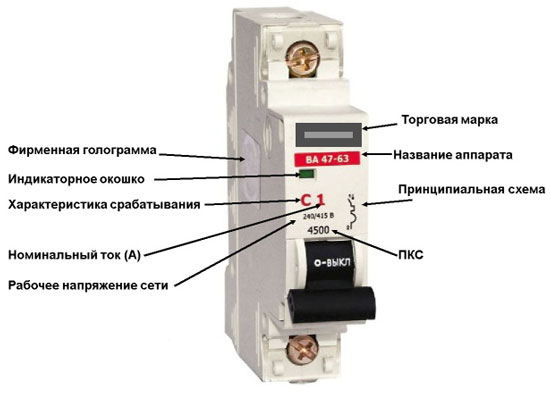
The first thing we pay attention to is trade mark. The price of the machine depends very much on the brand. European brands are much more expensive than their Chinese counterparts. Price and quality are interconnected.
Below is device name. In principle, the name of the device does not carry any useful information to us.
There are vending machines that may be present indicator window. A very necessary thing, but you can do without it. The fact is that situations are possible when, in the event of a short circuit, the contacts can be welded to each other, and the machine will switch to the off state. In case of repair, it is possible to be under dangerous voltage, therefore, the indicator window signals the status of the contacts.
The combination of letters and numbers - automatic response characteristic. One of the main characteristics of a circuit breaker. The letter indicates the time-current characteristic of the machine. The most common characteristics are B, C and D. B and C are suitable for home, and D for motors with high starting currents. This characteristic shows how quickly the circuit breaker will open in the event of a significant excess current compared to the rated current of the machine. The figure corresponds to the current value (in amperes) of the thermal release. Those. the number (characteristic of the thermal release) indicates the long-term permissible current of the machine, and the letter (characteristic of the electromagnetic release) indicates the characteristic of tripping the machine in case of short circuits and starting currents.
Mains operating voltage - the voltage at which this circuit breaker is capable of operating.
Digit 4500 (6000, 15000) - limiting current short circuit (PKS)... In other words, the PKS shows the maximum current at which the movable contact of the circuit breaker is not welded to the fixed contact as a result of an arc during short-circuit. This value also affects the dimensions of the machine. PKS over 10000A requires a large arc chute. One pole of such a machine usually takes 1.5 modules.
Schematic diagram the circuit breaker tells us which releases are in the circuit breaker. Almost all modular machines have thermal and electromagnetic releases.
On the side of the machine there may be branded hologram, which indicates that this is most likely a branded thing, and not a fake.
Another example of marking a circuit breaker in accordance with GOST R 50345-2010:

I think now you can easily identify any modular circuit breaker on the shop window.
As a manufacturer of the highest quality electrical products, it produces all types circuit breakers... Circuit breakers from ABB are divided into series according to characteristics and field of application.
Circuit breakers ABB S200 series
Circuit breakers of this series are used to protect circuits against possible overloads and short-circuit currents in electrical lines and cables for various purposes. They can be mounted on a standard DIN rail in electrical panels, cabinets and boxes.
The peculiarity of these circuit breakers is that they have greater reliability and increased switching capacity. Also, the S200 series is distinguished by a large assortment of devices presented.
Standard design and specifications series of automatic machines S200:
- ... simultaneous device of electromagnetic and thermal release,
- ... the number of poles has several variations:
- ... with a release on a phase and a neutral break on tripping (1 + N or 3 + N),
- ... with a release in each pole (1 or 3 poles),
- ... with release in phase conductors and neutral (2 or 4 poles).
- ... versions with different response characteristics (B, C, D as well as K and Z),
- ... versions with different characteristics of the limiting switching capacity (25 kA, 15 kA, 10 kA, 6 kA),
- ... presence of additional contact,
- ... the possibility of using the DDA-200 attachment to provide additional protection against leakage currents.
Marking and designations of the S200 series of ABB machines
STO S 201 C1
S20 - a series of automatic machines S200,
An additional letter indicates the breaking capacity:
- ... no letter - 6kA,
- ... letter M - 10kA,
- ... letter P - 15-25kA.
1 at end of series (S201) - number of poles:
- ... S201 single pole,
- ... S202 two poles,
- ... S203 three poles,
- ... S204 four poles.
The letter after the designation of the series and the number of poles is the characteristic of operation at short circuit (type of assignment of the machine):
- ... B - for protection when active loads (lighting lines with ground),
- ... C - for protection against active and inductive loads (low-power electric motors, fans, compressors),
- ... D - for protection at high starting currents and high turn-on current (transformers, arresters, pumps, etc.),
- ... K - to protect lines with active-inductive loads (electric motors, transformers, etc.),
- ... Z - for the protection of electronic systems with semiconductor elements.
The last digits in the designation are the ratings (settings) of the currents.
SH200L series circuit breakers
The SH200L series circuit breakers are a lightweight version of the S200 series circuit breakers.
The machines of this series have all the characteristics of the quality of ABB products and are designed for lighting systems and socket groups. But since in this series the machines have a low limiting switching capacity, it is not recommended to use them as input ones.
The parameters of the SH200L series circuit breakers differ little from the parameters of the S200 series circuit breakers, except for the limiting switching capacity (4.5kA). Also, the machines of this series are presented in a narrower assortment compared to the S200 series.
Rules for marking circuit breakers
All electrical products that belong to circuit breakers must be clearly legible. This marking should consist of symbols:
- ... trademark or manufacturer's name,
- ... type, serial or catalog designation (number),
- ... operating rated voltages with a symbol of the type of voltage (alternating (~) or direct),
- ... rated current in amperes with instantaneous release type letter (B, C, D, K, Z),
- ... rated frequency at one operating frequency,
- ... rated switching capacity at short circuit indicated in a rectangle with the same figure for constant and alternating current and in different rectangles with voltage type symbols at different digits,
- ... device diagrams (with complexity schema definitions),
- ... control air temperature (do not set for 30 degrees),
- ... IP degree of protection (not affixed to IP20).
The front panel indicates the type of release and the rated current, and all other information is applied to the side or rear surface.
If the input and output contacts need to be clearly distinguished, then they should be marked in the form of arrows (to the switch - input, from the switch - output).
The contact for the neutral is designated with the letter N. The contact for the protection conductor is identified with the earth symbol.
The designations of the circuit breakers should have maximum information about the device, which should give a clear picture of the presented device. The presence of the marking indicates the responsibility of the manufacturer to the consumer for the compliance of the declared characteristics with the real ones.
The variety of ABB circuit breakers is not limited to the series described and has a much wider range. ABB manufactures a wide variety of specialized circuit breakers for professional installation of electrical industrial circuits and systems for other applications.
It is easier and cheaper to prevent the fire hazardous consequences of the destruction of electrical wiring than to bitterly complain about the measures taken. Prevention of a fire in the electrical network consists in the installation of protective equipment. In the last century, the function of protection against short circuits and against the danger of overload was entrusted to porcelain fuses with replaceable fuses, then to automatic plugs. However, due to a significant increase in the load on power lines, the situation has changed. It's time to replace outdated devices with reliable machines. In order for the choice of a circuit breaker to end with the purchase of a device with the proper characteristics, information is needed about a number of electrical nuances.
Why do we need machines?
Circuit breakers are devices designed to protect the power cable, more precisely, its isolation from reflow and integrity violation. Automatic machines do not protect the owners of equipment from blows and do not protect the equipment itself. For these purposes, they equip an RCD. The task of the machines is to prevent overheating accompanying the flow of overcurrents to the entrusted section of the circuit. Thanks to their use, the insulation will not be melted and damaged, which means that the wiring will operate normally without the threat of fire.
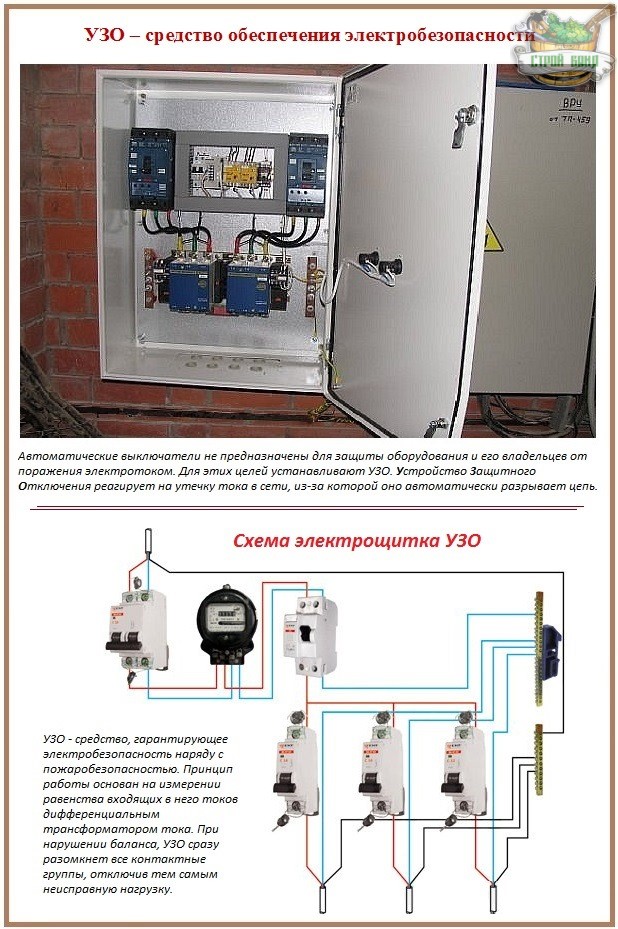
The work of circuit breakers is to open electrical circuit when:
- the appearance of TKZ (hereinafter short-circuit currents);
- overload, i.e. the passage of currents through the protected section of the network, the strength of which exceeds the permissible operational value, but is not TKZ;
- a tangible decrease or complete disappearance of voltage.
The machines are guarding the next section of the chain. Simply put, they are set at the input. They protect lighting lines and sockets, mains for connecting household equipment and electric motors in private houses. These lines are laid with cables of different cross-sections, because they are powered by equipment of different power. Therefore, to protect network sections with unequal parameters, protection devices with unequal capabilities are needed.
It would seem that it is possible to purchase the most powerful automatic shutdown devices for installation on each of the lines without unnecessary trouble. The step is fundamentally wrong! And his result will lay a direct "path" to the fire. Protection against electric currents is a delicate matter. Therefore, it is better to learn how to choose a circuit breaker, and install an apparatus that breaks the circuit when a real need arises.
Attention. An oversized circuit breaker will carry critical currents for wiring. It will not promptly disconnect the protected section of the circuit, due to which the cable insulation will melt or burn.
Slot machines with understated characteristics will also bring a lot of surprises. They will endlessly break the line when starting the equipment and, as a result, break due to repeated exposure to too high currents. Contacts are soldered, which is called "stuck".
The design and principle of operation of the machine
It will be difficult to make a choice without understanding the circuit breaker device. Let's take a look at what is hidden in a miniature box made of refractory dielectric plastic.
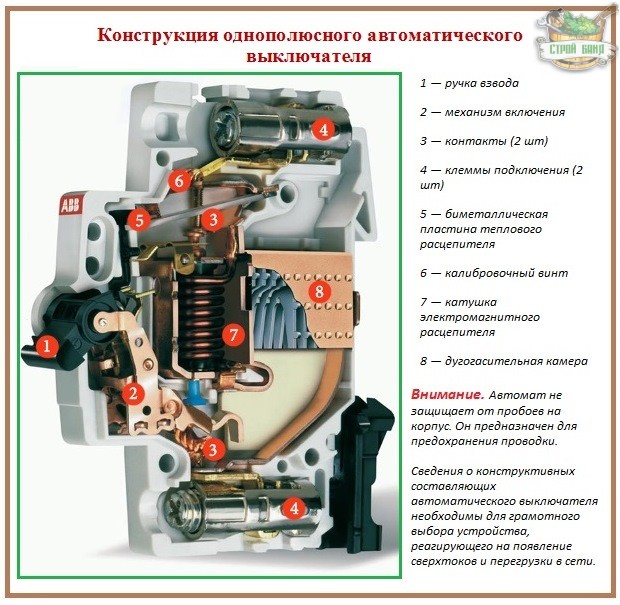
Releases: their types and purpose
The main working bodies of the circuit breakers are releases that break the circuit in case of exceeding the standard operating parameters. Releases differ in the specificity of their action and in the range of currents to which they must react. Among their ranks are:
- electromagnetic releases, almost instantly reacting to the occurrence of TKZ and "cutting off" the protected section of the network in hundredths or thousandths of a second. They consist of a coil with a spring and a core that is drawn in from overcurrents. When retracted, the core strains the spring, and it makes the trip device work;
- thermal bimetallic releasesacting as a barrier against overloads. They undoubtedly also react to TKZ, but they are obliged to perform a slightly different function. The task of thermal brothers is to break the network if currents pass through it that exceed the maximum operating parameters of the cable. For example, if a current of 35A flows through the wiring intended for the transportation of 16A, the plate consisting of two metals will bend and cause the machine to turn off. Moreover, she will courageously "hold" 19A for more than an hour. But 23A will not be able to “endure” the whole hour, it will work earlier;
- semiconductor releases they are rarely used in household machines. However, they can serve as a working element of the protective switch at the input to private house or on the line of a powerful electric motor. Measurement and fixation of anomalous current in them is carried out by transformers, if the device is installed on an alternating current network, or choke amplifiers, if the device is included in the line direct current... The decoupling is performed by the solid-state relay block.
There are also zero or minimum releases, which are most often used as an add-on. They disconnect the network when the voltage drops to any limit value specified in the data sheet. A good option are remote releases that allow you to turn off and on the machine without opening the control cabinet, and locks that fix the "off" position. It is worth considering that the equipment with these useful additions significantly affects the price of the device.
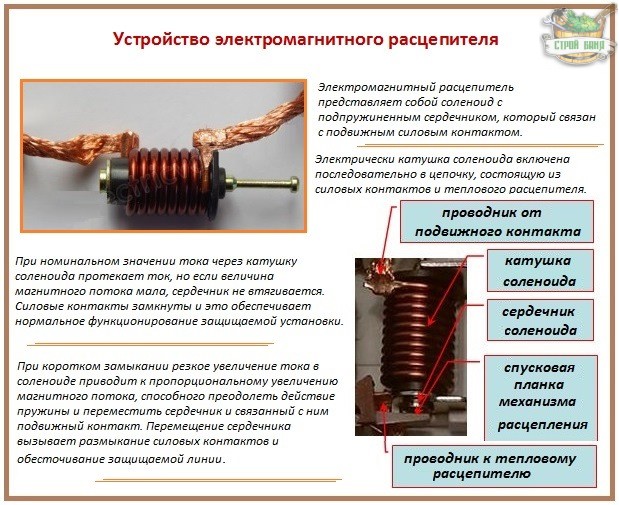
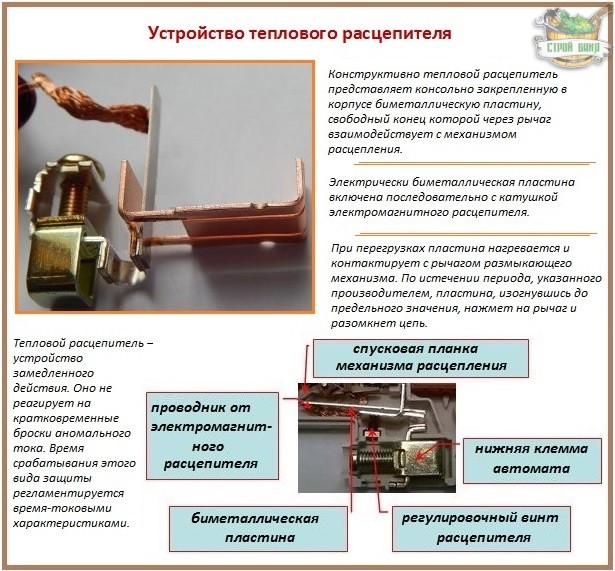
The machines used in everyday life are most often equipped with a well-coordinated combination of an electromagnetic and thermal release. Devices with one of these devices are much less common and used. All the same, combined type circuit breakers are more practical: two in one are more profitable in every sense.
Critical additions
There are no useless components in the circuit breaker design. All components work diligently in the name of a common protective cause, these are:
- an arc-extinguishing device, mounted on each pole of the machine, of which there are from one to four pieces. It is a chamber in which, by definition, an electric arc is extinguished, which occurs when the power contacts are forced to open. Copper-plated steel plates are arranged in parallel in the chamber, dividing the arc into small parts. The fragmented threat to the fusible parts of the machine in the arc-extinguishing system cools down and completely disappears. Combustion products are discharged through the gas outlet channels. A spark arrester is an addition;
- a system of contacts, subdivided into fixed ones, mounted in the body, and movable ones, pivotally attached to the semi-axles of the release mechanism levers;
- a calibration screw, with the help of which the thermal release is adjusted at the factory;
- a mechanism with the traditional inscription "on / off" with the corresponding function and with a handle intended for implementation;
- connection terminals and other devices for connection and installation.
This is how the arc extinguishing process looks like:
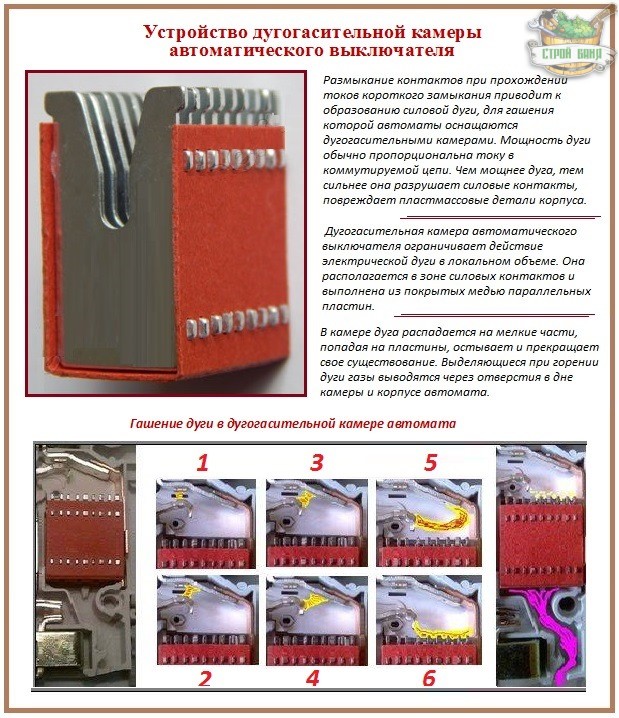
Let's dwell a little on power contacts. The fixed version is soldered with electromechanical silver, which optimizes the electrical durability of the switch. When a cheap silver alloy is used by an unscrupulous manufacturer, the weight of the product is reduced. Sometimes silver-plated brass is used. "Substitutes" are lighter than standard metal, therefore a high-quality device of a reputable brand weighs a little more than a "left" analogue. It is important to note that when replacing silver soldering of fixed contacts with cheap alloys, the resource of the machine is reduced. It will withstand less cycles of switching off and then switching on.
Let's decide on the number of poles
It has already been mentioned that the poles of this protection device can be from 1 to 4 pcs. It is as easy as shelling pears to choose the number of poles. it all depends on its purpose:
- a single-pole circuit breaker will perfectly cope with the protection of lighting lines and sockets. Mounted only per phase, no zeros!;
- a two-pole switch will protect the cable supplying electric stoves, washing machines and water heaters. If there is no powerful household appliances in the house, they are placed on the line from the dashboard to entering the apartment;
- a three-pole device is required for three-phase wiring equipment. This is already a semi-industrial scale. In everyday life, there may be a line of a workshop or a borehole pump. A three-pole device must not be connected to an earth conductor. He must always be on full alert;
- four-pole circuit breakers are used to protect four-wire wiring from fire.
If it is planned to protect the wiring of an apartment, bathhouse, house with two-pole and single-pole circuit breakers, first a two-pole device is installed, then a single-pole one with a maximum rating, then in descending order. The principle of "ranking": from a more powerful component to a weak, but sensitive.
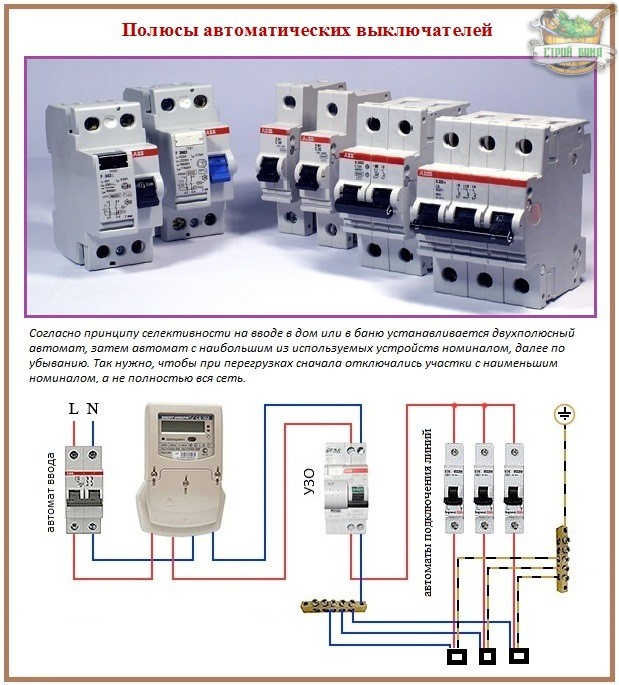
Marking - food for thought
We figured out the device and the principle of operation of the machines. We found out why. Now we can safely proceed to the analysis of the markings affixed to each circuit breaker, regardless of the logo and country of origin.
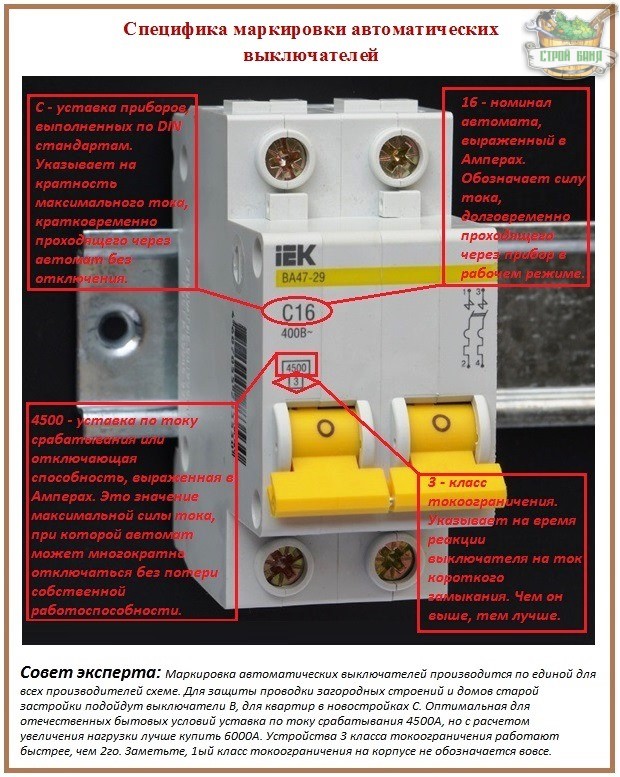
The main reference point is the denomination
Because the purpose of purchasing and installing the machine is to protect the wiring, then first of all you need to focus on its characteristics. The current flowing through the wires heats up the cable in proportion to the resistance of its current-carrying conductor. In short, the thicker the core, the greater the current can pass through it without melting the insulation.
In accordance with the maximum value of the current transported by the cable, the rating of the automatic shutdown device is selected. You don't need to calculate anything, the interdependent values \u200b\u200bof wiring devices and wiring by caring electricians have long been summarized in the table:
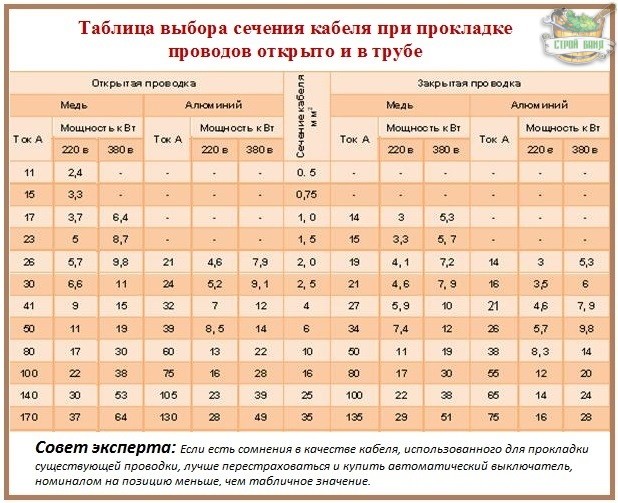
The tabular information should be slightly adjusted according to domestic realities. The prevailing number of household outlets is designed for connecting a wire with a core of 2.5 mm², which assumes, according to the table, the possibility of installing an automatic machine with a rating of 25A. The actual rating of the outlet itself is only 16A, which means you need to buy a circuit breaker with a rating equal to the rating of the outlet.
A similar adjustment should be made if there is any doubt about the quality of the existing wiring. If there are suspicions that the cable cross-section could not correspond to the size indicated by the manufacturer, it is better to play it safe and take an automatic machine whose rating is one position less than the table indicator. For example: according to the table, an automatic machine for 18A is suitable for cable protection, but we will take it for 16A, because the wire was bought from Vasya on the market.
Calibrated characteristic of the device rating
This characteristic is the operating parameters of the thermal release or its semiconductor analog. It is a coefficient multiplied by which we get the overload current that the device can hold or not hold for a certain period of time. The value of the calibrated characteristic is set during the production process, it cannot be adjusted at home. Pick it up from the standard range.
The calibrated characteristic indicates how long and how much overload the machine can withstand without disconnecting the circuit section from the power supply. Usually these are two numbers:
- the smallest value tells that the machine will pass current with parameters exceeding the standard for more than an hour. For example: an automatic machine for 25A will pass a current of 33A for more than an hour, without disconnecting the protected section of wiring;
- the highest value is the limit beyond which the trip will occur in less than an hour. The device indicated in the example will quickly turn off at a current of 37 Amperes or more.
If the wiring passes in a groove formed in a wall with impressive insulation, the cable will practically not cool during overload and the accompanying overheating. This means that the wiring can be badly damaged in an hour. Maybe no one will immediately notice the result of the excess, but the service life of the wires will be significantly reduced. Therefore, for hidden wiring, we will look for a switch with the minimum calibration characteristics. For the open variant, you don't need to get too hung up on this value.
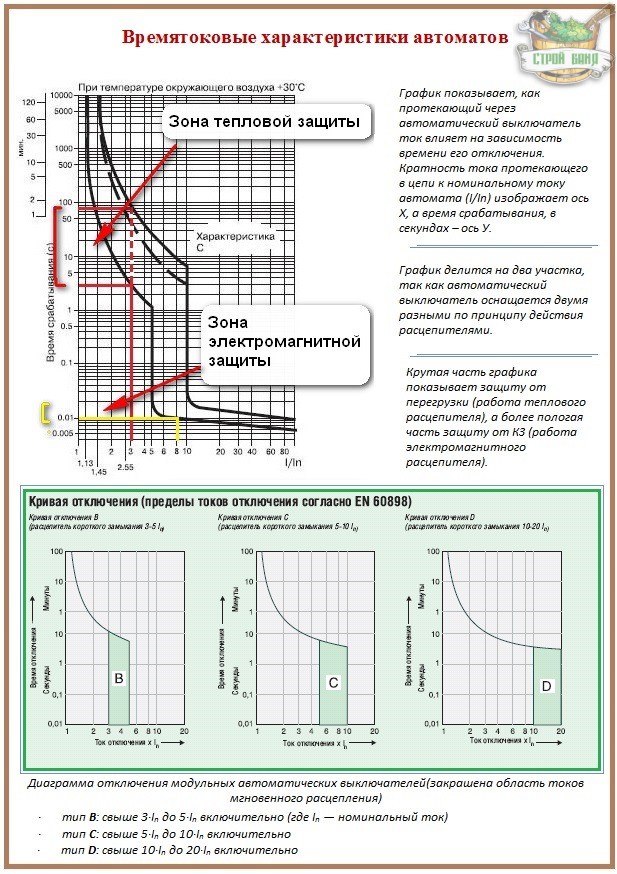
Setpoint - an indicator of instantaneous operation
This number on the case is the characteristic of the operation of the electromagnetic release. It denotes the limit value of the abnormal current strength, which, with repeated shutdowns, will not affect the performance of the device. It is normalized in current units, and indicated by numbers or Latin letters. With numbers, everything is extremely simple: this is the face value. But the hidden meaning of the letter designations is worth finding out.
Letters are affixed to machines made according to DIN standards. They denote the multiplicity of the maximum current that occurs when the equipment is turned on. A current that is several times higher than the operating characteristics of the circuit, but does not cause a shutdown and does not render the device unusable. Simply, how many times the turn-on current of the equipment can exceed the rating of the device and cable without threatening consequences.
Circuit breaker brands
Some manufacturers of quality devices mark them with QR codes, showing the full characteristics of electrical products.
Circuit breakers designation
You can trust such manufacturers and not be afraid for the quality of the device. The marking of the circuit breakers is applied to the front side of the case and must be resistant to external influences.
The main parameters for marking circuit breakers:
- manufacturer's name;
- serial number or product catalog number, GOST. Example BA47 - 29;
- the magnitude and type of voltage. Example 230/400;
- rated current, with the designation on the circuit breakers of the release type. Example C16, where C is the release type;
- the switching capacity indicated for alternating and direct current sources, in adjacent rectangles. Example 4500/3;
- usually the degree of protection ip20 is not specified. All other degrees of protection are marked on the device body; - the position of the switch lever Off / On or 0 / I must be clearly visible on the installed machines.
On the case there is a letter designation of the class of machines;
- A - for extended networks and electronic devices, where the short circuit current does not exceed 1-3 values \u200b\u200bof the rated current;
- B - for general networks;
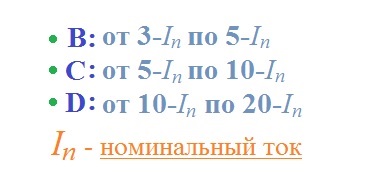
Transshipment ability B, C and D classes of automata
- C - for the lighting network, electric motors;
- D - for networks with a large number of powerful electric motors and a large starting current;
- K - for areas with inductive load.
Circuit breaker series
The most popular are class C machines, with an overload capacity twice as many class B machines. Next, let's look at popular companies and what machines they produce.
AE machines - these are vending machines. They have an unstable housing, are not DIN-rail mountable and have no electromagnetic shielding. It is better not to install such machines.
VA machines - these machines replaced the machines of the AE series and are already installed on a din-rail, with thermal and electromagnetic protection. They are produced with a rated current of 0.5 - 63A with class B, C and D. Their service life is up to 10,000 hours. Withstand short-circuit current up to 4.5 kA. They are produced by firms with the trademarks IEK, DEK, INTES, EKF, all of them are domestic producers.

Labeling of circuit breakers VA
Schneider Electric machines have a choice of current from 6 to 63 A of class C, D, service life up to 10,000 hours, overcurrent 4.5 kA. In terms of basic parameters, they are no better than their Russian counterparts, but more expensive.
Automatic machines ABB, Legrand, Siemens... These are high-end machines. They are characterized by a high quality housing with five fastening rivets (for grades below the rivets 4). They also have an overcurrent of up to 8 kA, a long service life and high mechanical strength. Indicators, covers and other excesses are installed on them as additional elements.
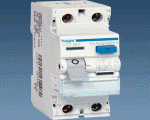
Contrary to popular belief, a circuit breaker or, more simply, an automatic machine is a complex electrical device that requires a competent approach. This applies not only to its use, but also directly to the choice. A wide variety of machines presented on the modern market dictates its conditions to the consumer, literally forcing him to navigate in the basic knowledge of electrical engineering. In order to avoid mistakes during the purchase of the device, you should definitely pay attention to the standard designations of certain parameters - the marking of the switches.
Each marking element indicated on the machine is a short form of data transmission about the technical and operational characteristics of the device. It will not be difficult to understand them even for a person who does not possess specialized knowledge in this area. The certified switch may indicate:
- Manufacturer and model (serial number).
- Nominal voltage readings. Universal machines can have two values \u200b\u200b- alternating current and direct current.
- Nominal frequency readings.
- For a universal device, it can be indicated both in one common and in several individual rectangles.
- Rated current. This indicator is preceded by the type of instantaneous release: B, C or D.
- Number of poles.
- The presence of built-in additional devices.
- Switching device design.
- On / off position marking.
- Current limiting class.
It is important to understandthat some marking elements may not be indicated, as well as, conversely, additional data may be available!
The importance of labeling circuit breakers
What should you look out for first?
All of the above labeling elements can be roughly divided into important and minor. When choosing a device, it is very important not to make a mistake with the following parameters:
- Circuit breaker rated current... The indicator indicates the current value at which the protective function of the device will operate. Some machines allow you to control it manually.
- Rated breaking capacity of the circuit breaker (limiting switching capacity). The parameter indicates the magnitude of the short-circuit current that occurs in the protected section of the circuit, at which the device will turn off its power.
The machine must strictly meet the expectations assigned to it. This is true not only for production networks, but also for home ones. It is very important to take into account the power of all devices and sum them up. Approximate data can be found in the attached table below.
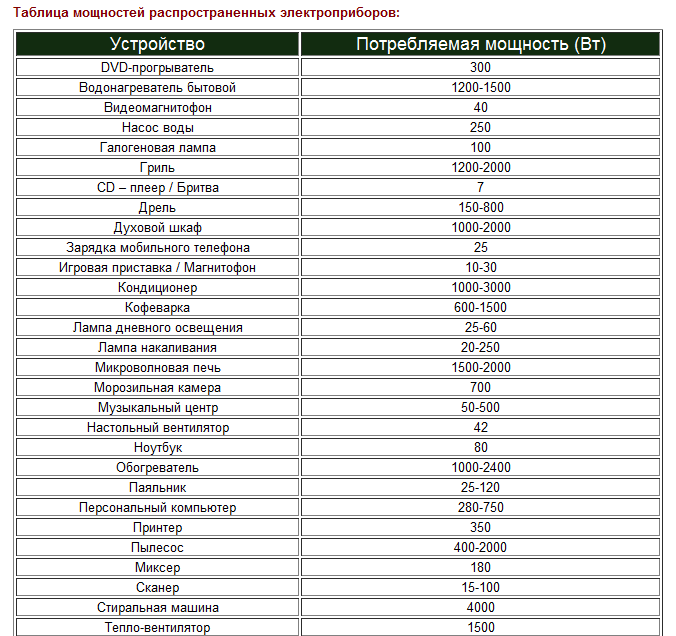
Power table of common electrical appliances
If necessary, different parts of the house can be connected to separate machines, which, for example, will help to limit the problem area that has arisen to only one room.
Device operation
In addition to the main marking elements, an important role in the selection of an electrical device is played by the ratings of the circuit breakers, which are responsible for the operational features. This includes requirements for temperature range, humidity percentage, and instrument location. A clear understanding of all operating conditions will help not only avoid breakdowns, but also increase the safety of working with equipment.
Generalized conditions for most of these devices look like this:

It is important to understand that all characteristics and requirements must be strictly observed, and they may be different from those mentioned in the text! Neglect of any of the indicators can damage the network as a whole and individual technical devices connected to it!




